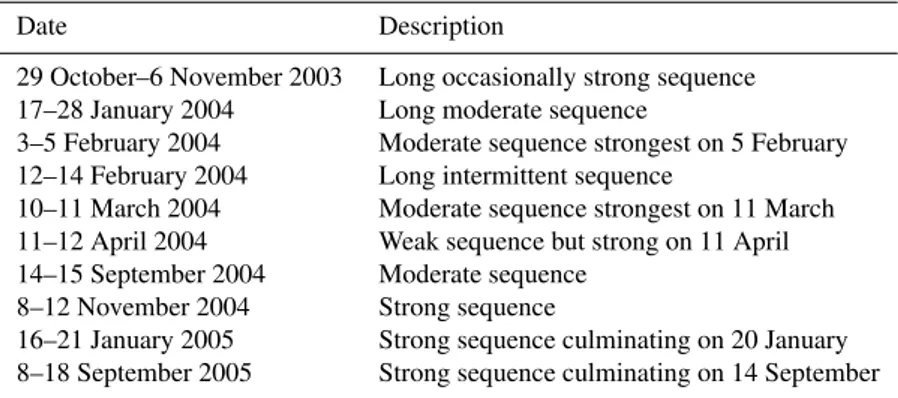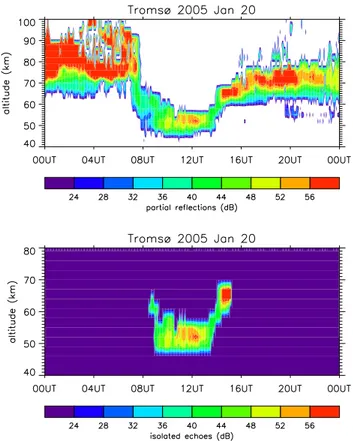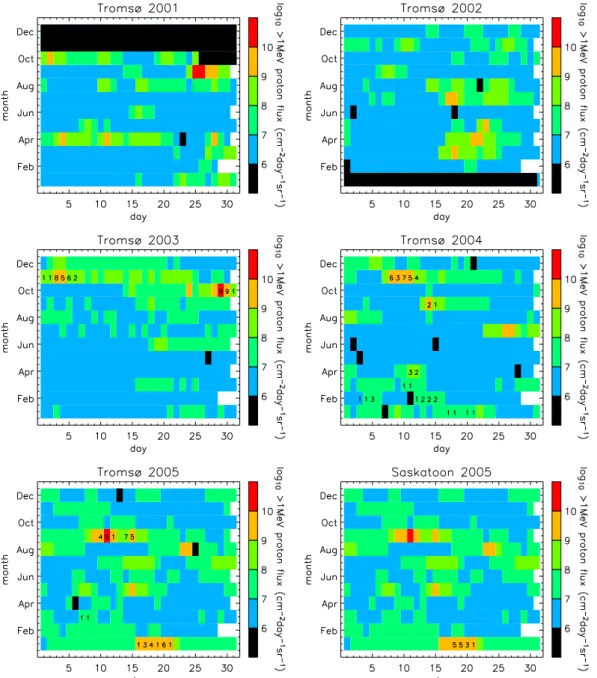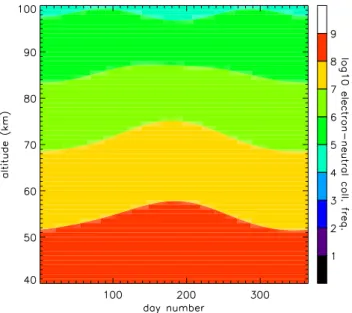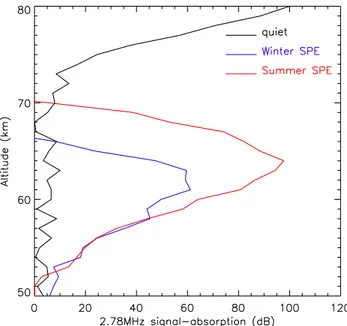www.atmos-chem-phys.net/6/5307/2006/ © Author(s) 2006. This work is licensed under a Creative Commons License.
Chemistry
and Physics
Isolated lower mesospheric echoes seen by medium frequency radar
at 70
◦
N, 19
◦
E
C. M. Hall1, A. H. Manson2, C. E. Meek2, and S. Nozawa3
1Tromsø Geophysical Observatory, University of Tromsø, Tromsø, Norway
2Institute of Space and Atmospheric Studies, University of Saskatchewan, Saskatoon, Canada 3The Solar-Terrestrial Environment Laboratory, Nagoya University, Nagoya, Japan
Received: 16 June 2006 – Published in Atmos. Chem. Phys. Discuss.: 4 August 2006 Revised: 10 October 2006 – Accepted: 20 November 2006 – Published: 23 November 2006
Abstract. We have noted sporadic instances of strong iso-lated reflections of medium frequency (MF) radar waves from the mesosphere from as low as 50 km altitude and have devised a set of criteria for isolating these apparently anoma-lous echoes from those normally occurring from progressive partial reflections in the D-region. The object of this study is to map the occurrences of such echoes facilitating com-parisons with other observations. For example, the similar-ity and simultanesimilar-ity of the echo structure for the 20 Jan-uary 2005 with VHF radar results presented by L¨ubken et al. (2006) are particularly striking. In presenting a number of such echo events since 2001 selected from the MF radar dataset (which spans 1997 to present), we find that virtu-ally all echo occurrences coincide with enhanced solar pro-ton fluxes suggesting that substantial ionisation of the meso-sphere is a necessary condition. Strong partial reflections of the radio wave in the lower mesosphere combined with seasonally varying total absorption higher up, thus giving false impressions of lower mesospheric layers preferentially in winter, constitute a scenario consistent with our observa-tions.
1 Background
Various instances of radar echoes, particularly at VHF, that are both unusually strong and limited in altitude extent have been reported, and Ecklund and Balsley (1981) have of-ten been credited with the first observations of Polar Meso-spheric Summer Echoes (PMSE). Predating this, however, Czechowsky et al. (1979) surveyed mesospheric structures visible at VHF in summer, autumn and winter and, fur-thermore, from mid-latitude, although these authors did not attempt to differentiate between backscatter or reflection
Correspondence to:C. M. Hall (chris.hall@tgo.uit.no)
mechanisms. It should come as no surprise therefore that phenomena described as Polar Mesospheric Winter Echoes (PMWE) (e.g. Kirkwood et al., 2002; Belova et al., 2005; L¨ubken et al., 2006; Zeller et al., 2006) and perennial equato-rial mesospheric echoes (e.g. R. Woodman and J. Chau, pri-vate communication) should exist. While the reader might be forgiven for asking why we refer to PMSE and PMWE etc., since anomalous echoes seem to appear all year round and at non-polar latitudes, perusal of L¨ubken et al. (2006) and references therein will quickly reveal that different mecha-nisms are visualized depending on height, latitude, season and method of observation.
The prime instrument used in this study is the Tromsø medium frequency (MF) radar situated at 70◦N, 19◦E
occurred in which the radio wave was strongly reflected from the lower mesosphere and that no radar returns were perceiv-able from the usual progressive partial reflections of the wave from irregularities in refractive index as it propagates through the D-region. The presence of such strong echoes below 70 km combined with absence of usable signal above is an unusual condition occurring on only a few days each year. This current study was instigated when we noted that the Jan-uary 2005 PMWE event reported by L¨ubken et al. (2006) at VHF coincided exactly with such a low-altitude strong re-flection at MF. Apart from determining reflected power, the Tromsø MF radar is able to measure both wind speed (from the motion of the reflected radio wave diffraction pattern on the ground) (Meek, 1980) and rough estimates of turbu-lent energy dissipation rates (from echo fading times) (Hall et al., 1998). The former are at too low an altitude reso-lution to be useful for estimation of wind shear and hence Richardson Number (Ri) and furthermore accurate tempera-tures and their gradients are not available for around 60 km above the radar site, these being necessary for determination of the Brunt-V¨ais¨al¨a frequency also needed for estimation of Ri. Unfortunately, neither can the co-located meteor wind radar (e.g. Hall et al., 2003) obtain intra-day wind and tem-perature information at such low altitude due to scarcity of meteor trail echoes. Finally, a co-located ionosonde (Hall and Hansen, 2003) is able to provide information on the state of the ionosphere, and, in particular the degree of particle precipitation for most anomalous echo events (although the system was off the air in January 2005).
2 Method
Normally, as discussed above, most of the reflected power received by an MF radar results from progressive partial re-flections from horizontally stratified structures in refractive index (a function of electron density at radio frequencies) extending over a Fresnel zone, as the radio wave propagates through the D-region; often, when the E-region is reached, the wave is substantially retarded by the increasing electron density and is ultimately reflected. This propagation of radio waves in an ionized medium is described by the Appleton-Hartree equation and more fully by the Sen-Wyller formula-tion (e.g. Hargreaves, 1992). If the electron density is suffi-ciently high, the radio wave may be completely absorbed, a condition which may be detected by checking whether the fminparameter from an ionosonde exceeds the radar fre-quency – a “blackout” in communications parlance. In order to obtain partial reflections from the mesosphere, there must be sufficient ionization, and this is usually created by inso-lation. Thus in winter at high latitude, during quiet auroral conditions, we often see a diurnal variation in signal with few or no partial reflections below heights at which the sun has not risen above the shielding ozone limb, while in sum-mer the sun illuminates the mesosphere all the time. A good
overview of ionization processes in the D-region (and for that matter above) can also be found in Hargreaves (1992). Given adequate plasma density, created by either auroral pre-cipitation or photo-ionization, partial reflections from as low as 50 km are not uncommon, especially for more modern radar systems than that at Tromsø. Here, however, we de-scribe more seldom isolated reflections from these low alti-tudes above which the radio wave is completely absorbed by the overlying ionosphere giving the appearance of a layer, as we shall show forthwith. Such echoes from low altitudes (viz. 40–70 km) were thus discerned by applying the follow-ing criteria:
(i) very low signal-to-noise ratios (SNR) for radar returns from all altitudes between 70 and 82 km inclusive, indica-tive of insufficient radio wave power propagating above the lowest echoes; we parameterize this by a failure to determine echo fading times at these heights.
(ii) maximum power in the region up to and including 68 km exceeding the typical echo power for D-region partial reflections under normal circumstances – 40 dB in our case.
(iii) filtering of the data at each altitude to exclude individ-ual 5-min profiles, thus the minimum duration of an echo in order to be selected was 10 min.
Table 1.Notable ILME events since 2001.
Date Description
29 October–6 November 2003 Long occasionally strong sequence 17–28 January 2004 Long moderate sequence
3–5 February 2004 Moderate sequence strongest on 5 February 12–14 February 2004 Long intermittent sequence
10–11 March 2004 Moderate sequence strongest on 11 March 11–12 April 2004 Weak sequence but strong on 11 April 14–15 September 2004 Moderate sequence
8–12 November 2004 Strong sequence
16–21 January 2005 Strong sequence culminating on 20 January 8–18 September 2005 Strong sequence culminating on 14 September
3 A survey of events since 2001
In principle reflected power data are available from the Tromsø MF radar since late 1996. However, at that time the rather ageing tube transmitter was delivering power con-siderably less than its original specification and in 1998 the system was upgraded with a solid state transmitter. There is evidence for ILME in 1997, but we shall not document it here since the selection parameters need to be tailored to the trans-mitter power. Other data analysis problems have resulted in incomplete years of searching for ILME, so we restrict our summary of findings to the complete years 2001–2005 inclu-sive, in this study. In Table 1 we have listed the most striking events during this period; this list is, however not exhaustive: isolated events will have to be examined individually. In par-ticular, we have attempted to document sequences of events in which echoes occur on consecutive days. We can also see that there is a dearth of events during summer, suggesting ILMEs to be winter phenomena. A more complete statistical study of echo occurrence will be required investigating echo height, time of day of occurrence, and states of the back-ground dynamics and ionization. We have selected three en-tries from Table 1 as examples of ILME sequences, shown in Fig. 2. In all three cases no significant events were seen on previous and successive days. Note that the ILMEs occur during daylight hours (lack of direct sunlight is indicated by hatching in Fig. 2) and that the base of the echoes tends to fall as the sun rises and vice versa. This signature effectively precludes ILMEs being related to layers formed by auroral particle precipitation (but not by solar proton flux). For the 2003 and 2004 sequences we have checked ionograms (not shown) and confirm that enhanced ionization is a feature of daylight hours. There are exceptions to this, however. For the short-lived night-time events in November 2004, we have ex-amined ionograms from the co–located Dynasonde (Sedge-more et al., 1996) (the Tromsø digisonde being inoperative between November 2004 and February 2005). Although we have not made an exhaustive comparison, it is evident that when the MF radar echoes appear, the ionogram “disappears”
(i.e. there is total absorption) and vice versa. We do not know, at this time, what has caused these enhancements in electron density. Since this study has a statistical character, we shall not investigate these few events in detail, although it may well transpire that these are related to auroral precipitation. On the 20 January 2005 (top panel of Fig. 2) in particular, we see evidence for the so–called “twilight effect” (Hargreaves and Birch, 2005; Mitra, 1974). Protons impinge on the polar cap all the time, the reason for the diurnal variation in the signal being the nighttime formation of negative ions which deplete the electron population. In this particular case, the evening twilight lasts about 2.5 h – the time from sunset to a solar depression angle of 10 degrees during which negative ions form and assume the night-time state. The twilight ef-fect is presumed to be responsible for the slight shift of echo occurrence with respect to local solar time as seen in a num-ber of plots on closer inspection.
Fig. 1. Tromsø MF radar results for 20 January 2005. Upper panel: echo power (dB) versus time and height; lower panel: iso-lated mesospheric echoes according to the criteria described in the text.
MF radars at Saskatoon (52◦N) and Platteville (43◦N) (e.g. Manson and Meek, 1989). ILMEs were also seen at Saska-toon on 18–21 January, but not September (Fig. 4), and no ILMEs were detected at Platteville whatsoever. Again, it should be stressed that the extension of our investigation to other sites is tentative, although the results hitherto are con-sistent with ionisation due to proton precipitation being re-stricted to mid- to high latitude.
A complete survey of PMWE events over the same time interval has not yet been compiled, however Kirkwood et al. (2002), Belova et al. (2005), Zeller et al. (2006) and L¨ubken et al. (2006) report events on (and around) 30 Oc-tober 2003, 10 November 2004 and 18–21 January 2005. On each of these occasions we have also observed ILME (see Fig. 3). Similarly L¨ubken et al. (2006) report an absence of PMWE on 25 and 27 January 2005, again in agreement with our observations.
4 Mechanism
Earlier we described the progressive partial reflection of the MF radio wave as it propagates into the lower ionosphere un-til total reflection occurs when the radio and plasma
frequen-Fig. 2. Three examples of multi-day sequences of isolated lower mesospheric echo occurrence. The horizontally hatched areas indi-cate when the sun was below the (solid earth) horizon.
cies are equal. For ILME to be total reflections, which would explain the lack of signal from above the ILME peak, an electron density of 9.6×1010m−3would be required. Dur-ing the 2005 event, an order of magnitude less than this was observed at 60 km, and elsewhere in the published literature (e.g. Hargreaves, 1992; Mitra, 1974, and references therein) there is a similar lack of evidence for electron densities suf-ficiently large to create total reflections in the lower meso-sphere.
Accepting, that the echoes at MF must be partial reflec-tions, we turn to the absorption of the radio wave in the height region above the ILME. To a first approximation we shall consider the case of non-deviative absorption since the path though the ionized media in the case of ILME is short com-pared to, for example to and from the E-region. Moreover, propagation of the radio wave is quasi-longitudinal with re-spect to the magnetic field at the latitude of Tromsø. Harg-reaves (1992) gives the absorptionA(dB) along the propa-gation pathx as:
A=4.5×10−5
Z N
eν
(ω±ωL)2+ν2
Fig. 3.Yearly tables of month versus day for Tromsø the period 2001-5 inclusive. For days when ILME were detected (by our criteria) the total numbers of hours are indicated. The background colours indicate>1 MeV proton fluxes. Black indicates whenever the Tromsø MF radar experienced operation problems of some kind. The lowest right-hand panel shows the corresponding statistics for Saskatoon 2005.
whereNe is the electron density, ν is the electron-neutral
collision frequency, ωis the radar frequency (all SI units), ωL=ecosθ (whereeis the local electron gyro frequency
andθ is the angle between the magnetic field and direction of propagation of the radio wave). At 70◦N θ is taken to be 12◦, the radar beam being vertical, andωLis of the
or-der of 10 MHz, which is somewhat larger than the MF radar frequency and not insignificant with respect to the electron-neutral collision frequency.
A cursory examination of Fig. 3 reveals that ILME is es-sentially a winter phenomenon as mentioned earlier. On the other hand, however, solar proton events are not restricted to any particular season. The clue to this dilemma lies in the seasonal variation of the electron-neutral collision frequency, ν, given by:
ν=5.4×1016Nn
p
Te (2)
whereNnis the neutral air number density andTeis the
Fig. 4.Sequence (16–21 January 2005) of ILME seen by the Saskatoon MF radar (52◦N), corresponding to the upper panel of Fig. 2. Note that the date axis is in UT and corresponds to that in Fig. 2, such that daylight hours occur some 7 h later relative to Tromsø.
Fig. 5. Electron-neutral collision frequencies as a function of sea-son and altitude, obtained by combining the NRLMSIS-00 model atmosphere (Picone et al., 2002) with expressions found in Brekke (1997).
the neutral temperature in the mesosphere) (Brekke, 1997). Figure 5 demonstrates the variation of ν with season and altitude using number densities and temperatures from the NRLMSIS-00 model (Picone et al., 2002): in the mesosphere there is a clear seasonal variation with maximum in summer, whereas at E-region heights the variation is actually bimodal and relatively flat. If we now take the semi-empirical elec-tron density profiles from L¨ubken et al. (2006) as typical situations, combine them with the values ofν from Fig. 5 in Eq. (1) and integrate the non-deviative absorption from 50 km to different altitudes (simulating the progressive ab-sorption of the MF radio wave as it propagates through the
lowest regions of the ionized medium – in one direction only for simplicity), we arrive at Fig. 6. Disturbed and quiet elec-tron density profiles are shown in the left-hand panel and ab-sorption of a 2.78 MHz radio wave in the right-hand panel. Here we can see that, taking one example, for a radio wave propagating to 64 km during a winter solar proton event, up to 100 dB would be absorbed, against only 50 dB in summer. Thus an electron density structure at 63 km altitude capable giving a radar echo of 60 dB (for example) in the absence of absorption, would, in fact be rendered invisible in winter, yet could remain visible in summer. We have simulated typ-ical MF radar power profiles, increasing monotontyp-ically with height in the absence of absorption, by simply dividing the Fig. 6 electron densities by 1010 for convenience, such that the echo from 80 km is of the order of 100 dB (an arbitrary value), taking 50 km as the base of the echo for the disturbed case and 70 km as the echo base for the quiet case, and then adding random dBs between 0 and 10 for realism. When we subtract the accumulated absorption for quiet, disturbed summer and disturbed winter cases we see, in Fig. 7 how ab-sorption creates the false appearance of layers in the lower mesosphere. That the electron neutral collision frequency is greater in summer than winter results in less absorption dur-ing summer for a given electron density profile. In winter the apparent layer is more restricted in height extent, in our rough simulation with a cutoff at 66 km. In summer the pro-file extends to around 70 km and could easily be rejected by our criterion for isolated echoes.
Fig. 6. Left: electron density profiles taken from L¨ubken et al. (2006) and presented as typical quiet (dashed line) and solar proton event disturbed (solid line). Right: resulting integrated non-deviative absorption as a function of season. Computations for progressively higher upper limits for the integral (Eq. 1) are shown, and with the 50–60 km interval for the quiet situation shown as a dashed line.
5 Conclusions
We have surveyed instances of unusually strong reflection of MF radio waves in the mesosphere from as low as 50 km altitude, which we refer to as isolated lower mesospheric echoes (ILMEs). What constitute “isolated” and “lower” are, to some extent defined by our selection criteria; however, we find that, on occasion, an MF radio wave is strongly partially reflected from the lower mesosphere and subsequently com-pletely absorbed in the upper mesosphere giving the impres-sion of a lower mesospheric layer. The routine analysis of MF radar data in order to obtain upper mesosphere winds can be expected to fail during ILMEs, due to lack of signal and we have used this very characteristic in identifying periods of interest. Checking three ILME sequences lasting several days (Fig. 2), we note a diurnal effect indicative of photo-ionization and/or proton precipitation, this being supported by examination of sequences of ionograms over the same pe-riod. Comparing with proton flux data from GOES space-craft, we ascertain that ILMEs of at least 1–2 h day−1 dura-tion are almost invariably associated with winter enhanced proton precipitation. These conditions are consistent with the background ionisation conditions for PMWE, deduced by Belova et al. (2005) and L¨ubken et al. (2006), although any relation to background turbulence (L¨ubken, 1996) has yet to be investigated. The review by Zeller et al. (2006) is arguably the best illustration of the degree of agreement be-tween PMWE and ILME occurrence. While further study is required to establish patterns in occurrence with respect to altitude, latitude, season, and background dynamics and ion-isation, accumulated observations to date show that ILMEs are winter phenomena. This is explained by the seasonal variation in electron neutral collision frequency and there-fore non-deviative absorption in the mesosphere. During
so-Fig. 7. Schematic illustrating conceivable profiles of MF radar re-turns. The black solid line shows a power profile from a quiet iono-sphere with no non-deviative absorption present. The red and blue lines indicate echo power from the same electron density profile during a solar proton event (SPE), but with summer and winter non-deviative absorption taken into account.
lar proton events more absorption in the mid- and upper-mesosphere in winter creates a false impression of a lower mesospheric layer, whereas in summer the echoes are dis-tributed over a larger altitude range.
the mechanism for the echoes at MF is one of strong partial reflections combined with an overlying total absorption of the radio wave giving a false impression of a low-lying mesospheric layer, and therefore differs from the volume scatter seen at VHF due to the order of magnitude difference in wavelength.
Edited by: F.-J. L¨ubken
References
Belova, E., Kirkwood, S., Ekeberg, J., Osepian, A., H¨aggstr¨om, I., Nilsson, H., and Rietveld, M.: The dynamical background of polar mesosphere winter echoes from simultaneous EISCAT and ESRAD observations, Ann. Geophys., 23, 1239–1247, 2005, http://www.ann-geophys.net/23/1239/2005/.
Brekke, A.: Physics of the Upper Polar Atmosphere, 401pp, John Wiley and Sons, New York, 1997.
Czechowsky, P., R¨uster, R., and Schmidt, G.: Variations of meso-spheric structures in different seasons, Geophys. Res. Lett., 6, 459–462, 1979.
Ecklund, W. L. and Balsley, B. B.: Long-term observations of the arctic mesosphere with the MST radar at Poker Flat, Alaska, J. Geophys. Res., 86, 7775–7780, 1981.
Gregory, J. B.: Radio wave reflections from the mesosphere. 1, Heights of occurrence, J. Geophys. Res., 66, 429–445, 1961. Hall, C. M.: The Ramfjormoen MF radar (69◦N, 19◦E):
Appli-cation development 1990–2000, J. Atmos. Solar-Terr. Phys., 63, 171–179, 2001.
Hall, C. M., Meek, C. E., and Manson, A. H.: Turbulent energy dissipation rates from the University of Tromsø/University of Saskachewan MF radar, J. Atmos. Solar Terr. Phys., 60, 437– 440, 1998.
Hall, C. M., Aso, T., Manson, A. H., Meek, C. E., Nozawa, S., and Tsutsumi, M.: High latitude mesospheric mean winds: a compar-ison between Tromsø (69◦N) and Svalbard(78◦N), J. Geophys. Res., 108, 4598, doi:10.1029.2003JD003509. 2003.
Hall, C. M. and Hansen, T. L.: 20th Century operation of the Tromsø Ionosonde, Adv. Polar Upper Atmos. Res., 17, 155–166, 2003.
Hall, C. M. and Husøy, B. O.: Altitude calibration of the Tromsø Medium Frequency Radar, Tromsø Geophysical Observatory Report, ISSN: 1504–1174, 13pp, 2004.
Hargreaves, J. K.: The solar-terrestrial environment, 420pp., Cam-bridge University Press, CamCam-bridge, UK, 1992.
Hargreaves, J. K. and Birch, M. J.: On the relations between pro-ton influx and D–region electron densities during the polar-cap absorption event of 28–29 October 2003, Ann. Geophys., 23, 3267–3276, 2005,
http://www.ann-geophys.net/23/3267/2005/.
Kirkwood, S. C., Barabash, V., Belova, E., Nilsson, H., Rao, T. N., Stebel, K., Osepian, A., and Chilson, P. B.: Polar mesosphere winter echoes during solar proton events, Adv. Polar Upper At-mos. Res., 16, 111–125, 2002.
L¨ubken, F.-J.: Rocket-borne measurements of small scale structures and turbulence in the upper atmosphere, Adv. Space Res., 17, (11)25–(11)36, 1996.
L¨ubken, F.-J., Strelnikov, B., Rapp, M., Singer, W., Latteck, R., Brattli, A., Hoppe, U.-P., and Friedrich, M.: The thermal and dy-namical state of the atmosphere during polar mesosphere winter echoes, Atmos. Chem. Phys., 6, 13–24, 2006,
http://www.atmos-chem-phys.net/6/13/2006/.
Manson, A. H. and Meek, C. E.: Heights of MF radar scatter (1986/87) and the wind field (55–95 km): Saskatoon, Canada, J. Atmos. Terr. Phys., 51, 1003–1016, 1989.
Meek, C. E.: An efficient method for analyzing ionospheric drifts data, J. Atmos. Terr. Phys., 42, 835–839, 1980.
Mitra, A. P.: Ionospheric effects of solar flares, 294pp., D. Reidel, Dordrecht, Holland, 1974.
Picone, J. M., Hedin, A. E., Drob, D. P., and Aikin, A. C.: NRLMSISE-00 empirical model of the atmosphere: Statistical comparisons and scientific issues, J. Geophys. Res., 107(A12), 1468, doi:10.1029/2002JA009430, 2002.
Sedgemore, K. J. F., Williams, P. J. S., Jones, G. O. L., and Wright, J. W.: A comparison of EISCAT and Dynasonde measurements of the auroral ionosphere, Ann. Geophys., 14, 1403–1412, 1996, http://www.ann-geophys.net/14/1403/1996/.
Sepp¨al¨a, A., Verronen, P. T., Sofieva, V. F., Tamminen, J., Kyr¨ol¨a, E., Rodger, C. J., and Clilverd, M. A.: Destruction of the ter-tiary ozone maximum during a solar proton event, Geophys. Res. Lett., 33, L07804, doi:10.1029.2005GL025571. 2006.
